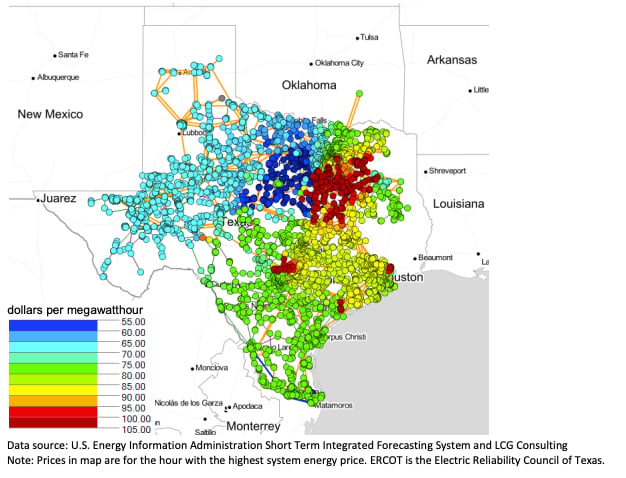Energy Procurement | February 12, 2024
POLR, LMP, Congestion - Just Some of the Things You May See on Your Energy Bill
Competitive energy markets offer many options to commercial and industrial customers. In ERCOT, retail electricity providers can customize pricing offers with dozens of cost components that can be tailored to specific consumer risk requirements. This allows buyers to make more strategic procurement decisions based on key operational priorities and energy usage patterns, but it has also added a new layer of complexity to the way energy is priced.
Below are a couple of terms to pay attention to because they are probably new to you and can influence the electricity rate you pay drastically.
Provider of Last Resort (POLR)
The Public Utility Commission has designated Providers of Last Resort (POLR) as a back-up electric service provider in each area of Texas open to competition. POLR service is relatively high-priced, due to the costs associated with planning and the risk of serving an uncertain number of customers with uncertain electricity loads. POLR service is a safety net for customers whose chosen REP is unable to continue service. This service is intended to be temporary and used only under rare circumstances when a REP is unable to provide service, or when a customer requests POLR service.
Generally, the designated POLR will switch you to one of their variable-rate electricity plans if you’re still on the POLR plan after 60 days. However, waiting for this point is not recommended at all: by then, you will have paid above-average electricity prices for two months.
Some Examples:*
TXU (Oncor) POLR Cost is between 18-20 cents per kWh, depending on usage. Compared to 6-8 cents with competitive supply.
Reliant (AEP North) POLR Cost is around 19 cents per kWh. Compared to 6-8 cents with competitive supply.
*NOTE: This information is based on early 2024 data and may change by the time you are reading this article.
But why does Texas have POLRs?
Before Texas energy deregulation, utilities controlled both the energy supply and the process of selling energy to consumers in their service area. Now these utilities are only in charge of distributing electricity to consumers while competitive REPs sell electricity to consumers, allowing customers to choose their own electricity providers, plans, and prices. To keep the utilities out of the business of selling energy, policymakers created the POLR structure, which requires competitive REPs to serve customers if their REP leaves the market.
Every two years, PUCT designates certificated REPs to provide POLR service for each service area. The largest providers are required to serve as POLR and smaller providers may volunteer to participate.
You may also hear this referred to as Designated Default Retail Electric Provider (DREP). A DREP will be assigned to customers who do not choose a provider during the designated shopping period.
Nodal Pricing
Nodal pricing, also known as locational marginal pricing, is a method used in some electricity markets to determine the price of electricity at different locations, or nodes, in the grid.
In a nodal pricing system, prices are determined at the transmission substation level. These prices reflect the costs of electricity generation, transmission losses, and possible grid congestion2. This provides economic signals to market participants, enabling them to account for these factors in their operational decisions. It also encourages future producers, consumers, and storage operators to choose their locations based on these prices.
The main benefits of nodal pricing include increased efficiency in the dispatch of generating units and reduced re-dispatching costs. By better signaling local grid conditions, nodal pricing provides generators and consumers with adequate incentives, taking into account the physical constraints, both when investing in new capacity and when trading energy on the wholesale market.
The specific nodal charge we deal with on our end is congestion. This is the price difference between the energy price at the source (HUB aka the generator) and the energy price at the destination (the load zone, which is the average price of nodes in a zone).
Example of Nodal Pricing Map

A simple way to think about it.
Nodal pricing is like setting different prices for bus tickets depending on how crowded the bus is and how far you’re going. In electricity markets, it’s used to set prices at different points (or “nodes”) in the power grid.
Here’s why it’s used:
It helps match supply and demand: If a part of the grid is congested, prices go up, encouraging less use and more supply.
It guides future decisions: If prices are consistently high in an area, it signals that more power plants or less usage is needed there.
These costs vary across the state. We can help determine if the "insurance" premium to include these costs outweighs the risk of passing them through as a line item on your bill that varies each month.
Examples
The 5 year average for nodal congestion in the west zone is 0.00681/kWh peaking at 0.0467/kWh in March of 2020. The average premium to include in your contract is about 0.002-0.003/kWh. In this case, the insurance makes sense to include it in your contract and should result in significant savings.
The 5 year average for nodal congestion in the north zone is 0.00051/kWh peaking at 0.00221/kWh in August of 2023. The average premium to include in your contract is about 0.0008-0.0012/kWh. In this case, passing congestion through should result in savings over the premium to include, although there is assumed risk and monthly fluctuations.
So, what does this mean to me?
It's important that customers make an informed decision when determining the best electricity contract structure for them. At Mantis, we pay close attention to energy bills and supplier contracts so that our clients are well-educated and can confidently move forward with the right contract. With so many intricacies to an electricity contract in Texas, it's crucial for you to work with someone you trust.
Please don’t hesitate to reach out and ask us anything!
Related Posts
Discover more content and insights from Mantis Innovation

The Cost of Inaction: Why Businesses Should Act Now on Energy Efficiency
In today's fast-paced business environment, the financial and operational losses businesses incur by delaying energy efficiency improvements, the "cost of inaction," is more relevant than ever.

Navigating Energy Procurement: Strategies to Manage Risk
When procuring energy for your commercial business, it can be difficult to weigh the risks associated with buying strategies. How do you know your procurement strategy is the right one? How

6 Facts about Energy Services in Efficiency Projects
As a nationwide firm with design/build capabilities, we identify, design, and deliver efficiency projects for clients across the United States. These projects are rooted in several core energy

PJM Capacity Auction Results: A Surge in Prices and Its Implications
PJM recently released the capacity auction results at the end of July for the period of June 2025 through May 2026, and the outcomes have been much higher than most anticipated. This surge in prices